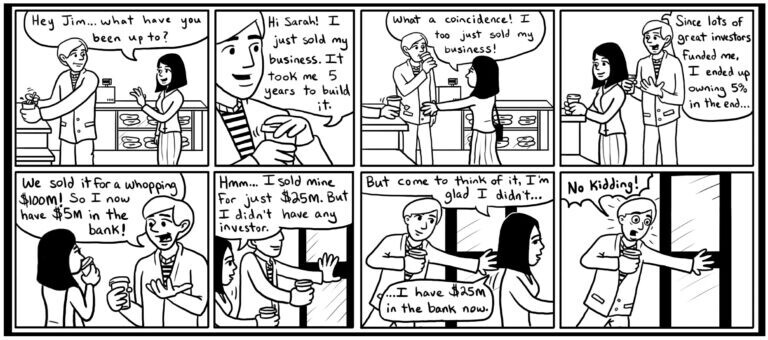Best of Bootstrapping: Bootstrapped a Technology Product Company from India

If you haven’t already, please study our Bootstrapping Course and Investor Introductions page.
Some of us have worked relentlessly for decades to bring about the change in India from a largely services-driven technology industry to one that today produces credible products sold all over the world.
Ameyo is one of the early examples of this shift, and Co-founder CEO Sachin Bhatia is an early visionary in this journey. Ameyo was acquired by Exotel earlier this year.
Sachin is also a long-term reader of this blog. It is always a great pleasure for me to do the Entrepreneur Journeys of my long time readers who have benefited from these stories and the invaluable lessons shared by so many entrepreneurs since 2006. This is our conversation from December 2020.
Sramana Mitra: Let’s go to the beginning of your journey. Where are you from? Where were you born and raised? What kind of background did you have?
Sachin Bhatia: I was born in New Delhi, India. I graduated from IIT. I’m a computer science graduate. I did my Bachelors in Computer Science in 2001. I have my whole family in India. My father was in the manufacturing business. In our college days, we thought that India should make some more products. That is how the journey started. I started this with a couple of my batchmates at IIT.
Featured Videos
Cloud Stocks: Freshworks Faces Growing Competition from AI-Focused Support Services Providers

San Mateo-based Freshworks (Nasdaq: FRSH) is focusing on deploying AI capabilities across all its offerings. It recently reported its quarterly results that outpaced market expectations. The overall economic conditions resulted in a weaker outlook.
>>>From Developer to Entrepreneur with $20M in Bootstrapped Revenue: Julien Salinas, CEO of NLP Cloud (Part 1)

Numerous developers around the world are turning into successful entrepreneurs. Julien provides a textbook case study of a brilliant journey that is a highly repeatable blueprint to follow.
Sramana Mitra: Let’s start at the very beginning of your journey. Where are you from? Where were you born, raised, and in what kind of background?
>>>Video FAQs
Can 1M/1M Help Me Raise Money?
How Does 1M/1M Democratize Entrepreneurship Education?
How Does 1M/1M Democratize Management Consulting?
When Is The Right Time To Join 1M/1M?
Can 1M/1M Help Me With Business Development?
Can 1M/1M Help Me With Market Sizing?
Can 1M/1M Help Me Validate My Product?
Will I Have Private 1-on-1 Sessions In 1M/1M?
How Does 1M/1M Help Entrepreneurs Connect With Silicon Valley?
Mentoring or Consulting?
Why Does 1M/1M Charge $1000 a Year?
Why Does 1M/1M Partner With Local Organizations?
Why Don\’t Mentoring Networks Work?
Why Is It Important To Study With 1M/1M Now?
Dan Stewart Story
Vikrant Mathur Story
Thought Leaders in Artificial Intelligence: EdgeVerve CEO Sateesh Seetharamiah (Part 4)
Sateesh Seetharamiah: I’ll give you an example. Today, 80% of data is hidden in documents in enterprises and is very inaccessible. Why don’t we apply AI to solve this problem? Let’s build a horizontal platform – a domain-agnostic platform – to extract information. While the platform can do it, as soon as you start throwing it to a customer, they say, “What do I do with it?” It’s a very natural question.
We went through an exercise of saying, “What are the areas that we can pick?” This is a problem that’s faced by many entrepreneurs. We don’t have domain capabilities. We are technologists. We build horizontal platforms. How do I bridge that gap? We decided to engage with a customer.
>>>Cloud Stocks: Twilio’s Solutions Target Customer Lifetime Journey

According to a recent report, the Unified Communications as a Service (UCaaS) market is estimated to grow 10% CAGR to reach $44.7 billion by 2030 from $20.4 billion in 2022. Communications PaaS player Twilio (NYSE: TWLO) recently announced its third quarter results that surpassed market expectations. But a weaker outlook has sent the stock tumbling.
>>>Best of Bootstrapping: Bootstrapped Lawline to $10M

If you haven’t already, please study our Bootstrapping Course and Investor Introductions page.
Wonderful story from 2020 of how Lawline CEO David Schnurman, an online education entrepreneur, had worked through plateaus and scaled his business over 15 years.
Sramana Mitra: Let’s start at the beginning of your journey. Where are you from? Where were you born and raised? What kind of background did you have?
David Schnurman: I’m from Brooklyn, New York, an area called Park Slope. It’s a beautiful area. I grew up there until I went to college in Washington DC where I met the love of my life, who’s here with me in Barcelona. We met in college and then I moved back to New York.
Thought Leaders in Financial Technology: Evgen Verzun, CEO of Kaizen Finance (Part 2)
Sramana Mitra: You work through incubators and accelerators.
Evgen Verzun: Yes. They come to us through the network. Somehow, they reach investors, right? These investors already have a successful experience with Kaizen. Investors refer us. Investors use us as crisis managers. It’s like, “We have a great project, but they have a huge problem.” We jump in and solve it. It’s tough, but we can do it very fast. It’s small pieces of the puzzle that we can put together.
Sramana Mitra: How many such customers do you have?
>>>Thought Leaders in Artificial Intelligence: EdgeVerve CEO Sateesh Seetharamiah (Part 3)
Sramana Mitra: The use case that you just described works a lot better in automation than as humans. For humans to look at things and decide at what price to bid and whether to bid or not, there is no way humans can beat AI in doing something like this.
Sateesh Seetharamiah: It was done by humans. Even today.
Sramana Mitra: Wall Street traders made huge amounts of money in functions that don’t need to be done by humans.
>>>